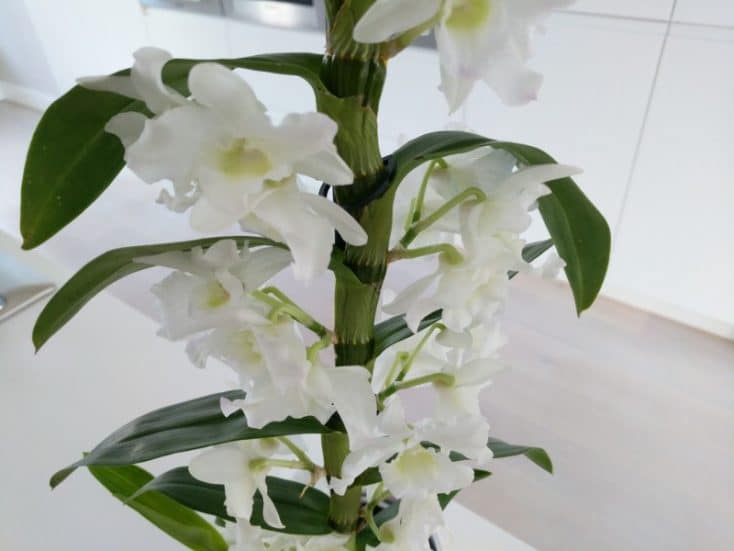Dendrobium Nobile orchids are one of the most popular species of orchids. Their profuse, beautiful, delicately scented flowers produce a wonderful display for up to several months at a time. This article is going to walk you through how to care for dendrobium
How to care for a dendrobium
I’ve so many useful tips to share and all the details about caring for dendrobium orchids. So read on and I’ll tell you everything you need to grow amazing dendrobium
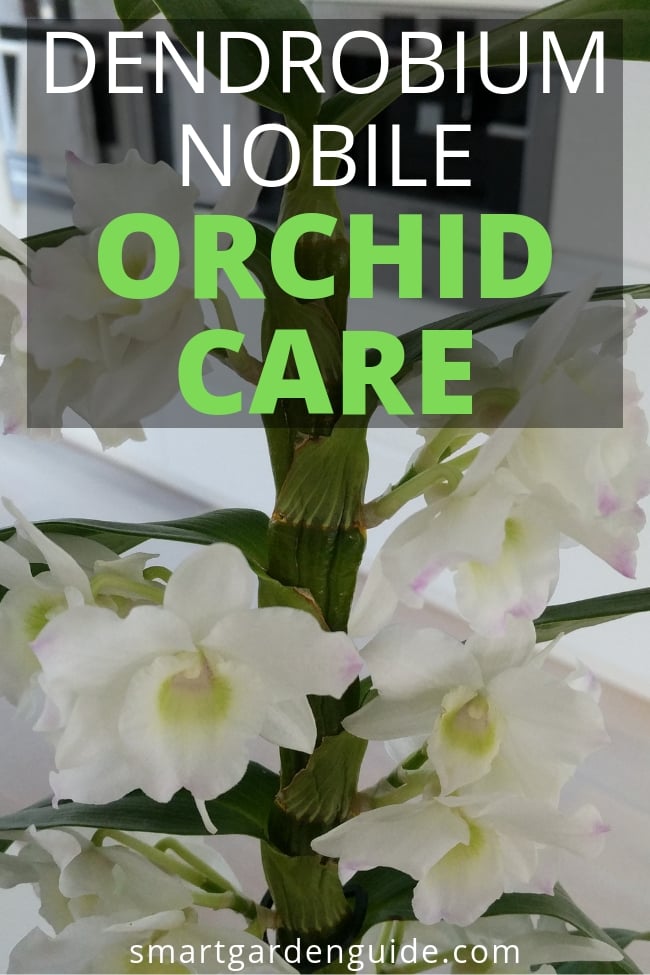
Dendrobium Nobile Light Requirements
Dendrobium nobile orchids require and tolerate more light than most other commonly cultivated orchids. They are best kept in bright light conditions all year round. In the winter, they can tolerate direct sunlight, but in the heat of the summer, you should limit direct sunlight to a few hours in the early morning or late afternoon.
A south-facing window is best during the winter, spring and autumn, but they are better moved to an east-facing window in the hottest months of summer, to reduce the risk of leaf scorching.
If you notice wrinkled leaves, brown shrivelled leaf tips, or yellowing or fading leaves, this can be a sign of excessive lighting, and you should move your dendrobium nobile to a location with less intense light conditions.
Watering Dendrobium Nobile Orchids
The water requirements of dendrobium orchids vary during the year. During active growth of the orchid in the summer, water thoroughly once the potting media is almost dry. Use your finger to monitor the dryness of the potting media, to get an idea of when it needs watered.
Another good tip is to monitor the weight of the pot. By lifting the pot, and judging the weight, you will soon know when the potting media is dry and can get a good idea of when it needs
Try to ensure that you provide your dendrobium
Frequency of watering will depend on a number of factors including the size of the pot, how root bound the orchid is, the temperature and ventilation conditions the plant is being grown in. Be guided by the condition of the orchid and dryness of the potting media, rather than watering on any set schedule or a certain number of days.
Each time you water your dendrobium nobile, soak the potting media thoroughly and allow the water to run out the bottom of the pot. Water your dendrobium nobile orchid in the morning if possible. Increased heat, light, and ventilation during the day allows excess water to evaporate, which is particularly important to reduces the risk of fungal disease.
Once the canes produce the last of their leaves in the autumn, and growth slows, reduce watering significantly. You should monitor the canes for signs of drying out, and water just enough at this time to prevent the cane from shivelling or the leaves from wilting.
You may only have to water your dendrobium nobile every 2-3 weeks at this time. Relative water deprivation is an important step in encouraging bud and bloom development.
Once you see new buds starting to develop, you can increase watering again, to provide sufficient water throughout the blooming phase.
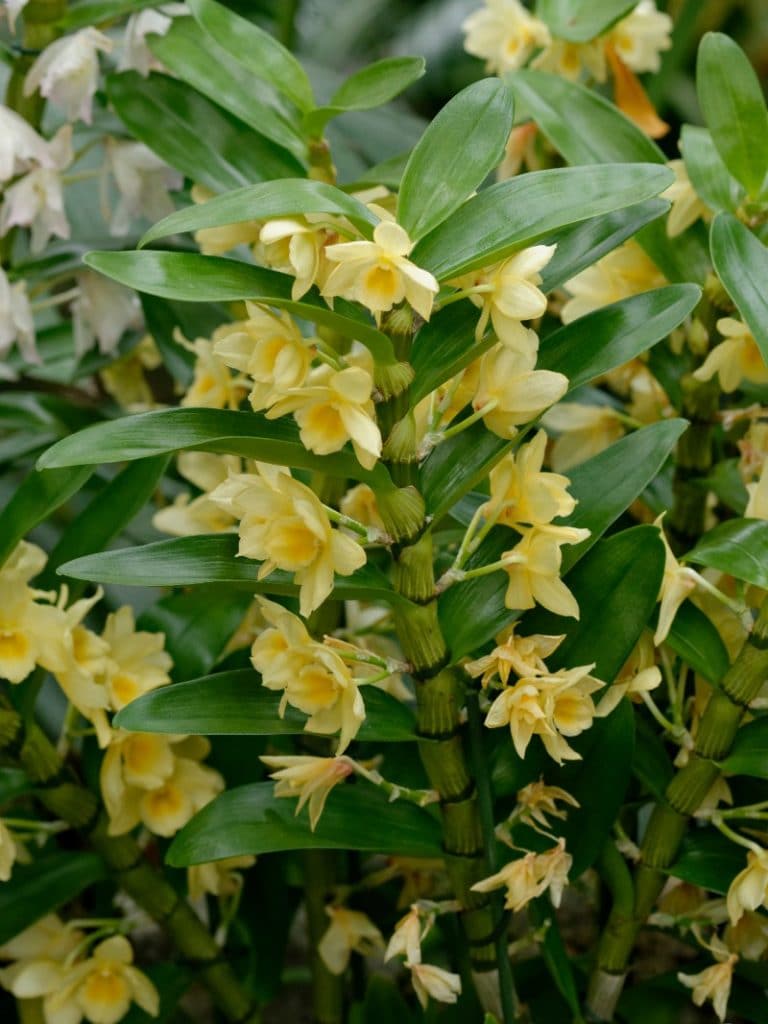
What Temperature Do Dendrobium Orchids Need?
Dendrobium nobile orchids are quite tolerant of variations in temperature throughout the year and between day and night. However, to get the best out of your plant and encourage it to rebloom year after year, you should provide quite specific temperature conditions in the autumn.
During blooming and active growth phases, from February to September,
In the autumn, from October to January, they require cooler temperatures, with significant variation between day and nighttime temperatures, to stimulate bud and bloom development.
Dendrobium Nobile Humidity Requirements
Dendrobium nobile orchids are less sensitive to humidity conditions than many other species, but 50-70% humidity is ideal. With higher humidity levels, the need to ensure adequate ventilation increases, to reduce the risk of disease.
If you need to increase humidity levels for your dendrobium nobile orchids, consider a humidity tray, or grouping plants together. If needed, monitor the humidity level of your growing environment with a hygrometer. I use a simple digital thermometer/hygrometer for my indoor plants to ensure I am providing the best conditions.
Air Circulation
As dendrobium nobile orchids require fairly high levels of humidity, this can predispose them to fungal disease, unless sufficient airflow is provided. Opening a window in a poorly ventilated house, or using an oscillating fan can greatly reduce the risk of disease. Just be careful not to expose your orchid to cold drafts, which can cause bud drop on occasion.
Potting Media For Dendrobium Nobile
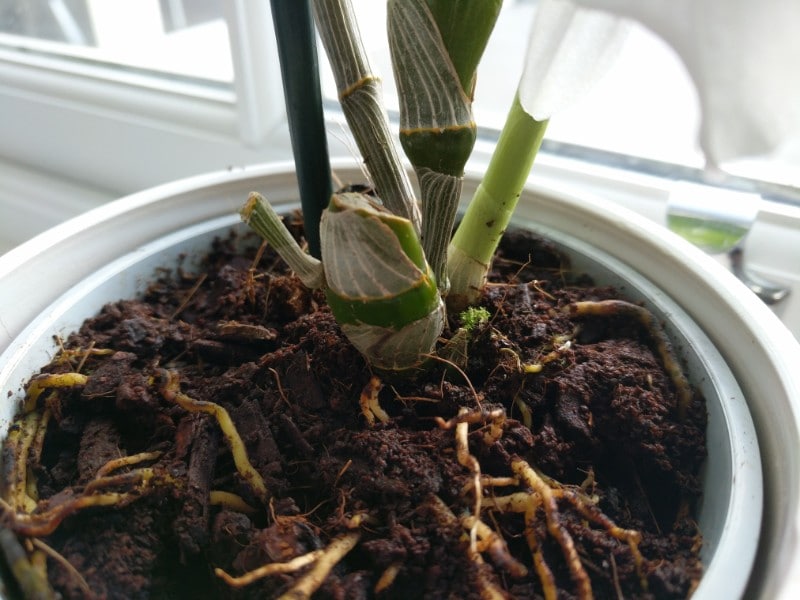
Dendrobium orchids are epiphytic plants, which means that in nature, they grow attached to other plants, rather than in soil. For this reason, you should ensure that your dendrobium
A good quality pre-prepared orchid mix will be ok, or you can make your own. An equal mix of coarse pine bark, coconut husk
Choice Of Potting Container
The potting container must have plenty of drainage holes and should not be excessively large. Dendrobium nobile orchids tolerate being root bound very well, and avoiding excessive potting media around the roots will improve drainage and aeration of the roots.
I normally use a plastic pot that is just big enough to hold the roots of the
This also makes it easy to take the inner pot to the sink to water the orchid, allowing it to drain thoroughly, before returning it to its decorative pot.
Clay pots are possibly an even better option, as the porous nature of clay allows for more rapid drying of the potting media and reduces the risk of root rot.
Fertilizing Dendrobium Nobile Orchids
Fertilize your dendrobium
Dendrobiums are at risk of nutrient toxicity and root burn if excessively strong fertilizer is used, so fertilizing at half strength reduces this risk significantly.
If fertilizing weekly, just use water every 4th week and thoroughly soak the potting medium to flush the excess fetilizer salts from the potting medium.
Another issue with overfertilizing, or using a fertilizer which is particularly high in nitrogen, is that this can casue too much green leafy growth, or promote the production of keikis (baby plant offshoots), which will divert the plant’s energy from producing further blooms.
From October, stop fertilizing as this is part of the process to stimulate reblooming, along with reduced watering and exposing your dendrobium nobile to cooler temperatures.
Don’t start fertilizing again until flowering has almost finished.
Dendrobium Nobile Blooms
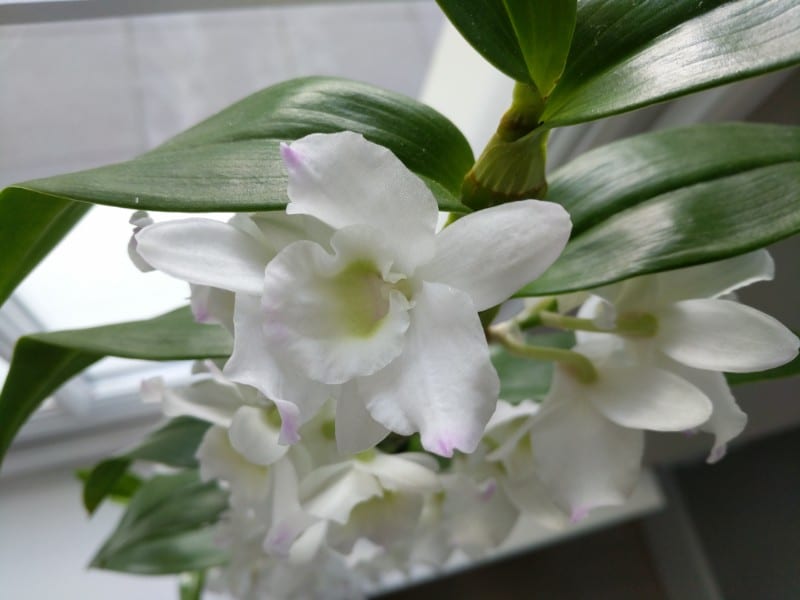
The flowers of dendrobium nobile orchids are beautiful, delicate and numerous. Buds form on small flower spikes of no more than a few centimeters in length, that grow from the stem, in between pairs of leaves. A single dendrobium nobile cane can have 25-50 blooms and a plant with several canes blooming will produce a spectacular display.
The flowers have a light, sweet scent, which is pleasant, but not overpowering.
Buds normally develop in December and January, with blooming from January to March in the northern hemisphere. Blooms typically last for at least 6 weeks. Cooler conditions and healthy plants given good care can extend blooming for up to 12 weeks in total.
Pruning And Care After Flowering
After your plant has finished flowering, you should trim the flower spikes off close to the cane. Do not cut a cane that has finished flowering, as an individual cane can rebloom the following year, but they also contain a store of energy which the plant can use to grow new canes and vegetative growth, leading to bud and bloom development on a new cane.
Cutting an old cane removes this energy source, and it is more difficult for the orchid to produce new canes the following season.
Reblooming
Once blooming has finished, increase watering, begin regular fertilizing, keep it in temperatures of between 65-85 °F (18-30°C) and ensure it gets plenty of bright light to maximize vegetative growth. You can expect at least some leaf drop from the canes which have flowered, and this is to be expected as dendrobium
You can expect new vegetative growth to develop over the months of April to August, and it is normal for one or more new pseudobulbs to develop, which will be the most likely site of blooming the following winter.
Eventualy, the canes will stop producing new leaves, and as you enter the autumn, this is the time to reduce watering, stop fertilizing and reduce the temperatures the orchid is grown in.
Dendrobium
After the plant has been exposed to at least 4 weeks of colder conditions and cooler nights, you can expect buds to develop in about 40-50 days. Once buds develop, you should ensure that you avoid exposure to temperatures below 54 °F (12°C) F to reduce the risk of bud drop.
Interestingly, some of the newer varieties of dendrobium nobile orchid will bloom without these specific care requirements, but unless you are absolutely sure, I would recommend following the above advice.
Staking Dendrobiums Orchids
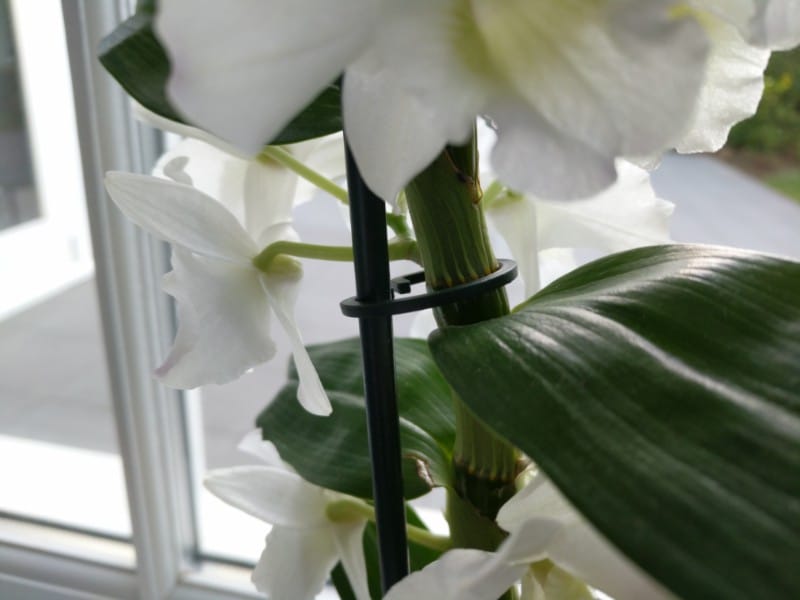
Dendrobium nobile orchids are very top heavy, and should be staked to ensure the canes grow as you wish them to and to reduce the risk of the pot toppling, which is likely, if the canes of your plant are growing at an angle, away from the centre of the pot.
Place a stake close to and parallel with the cane and loosly attach the cane to the stake with clips or wire which do not restrict the growth of the orchid.
Obviously, this is not the natural way for dendrobium nobile orchids to grow in nature. They normally grow attached onto another plant and the canes hand down from the plant. You can try this alternative way of growing your dendrobium nobile orchid as long as the pot will not topple, or try growing them in a hanging basket or wall mounted planter.
How To Repot A Dendrobium Nobile Orchid
Dendrobium nobile orchids like to be root bound, so only repot every 2-3 years, and only to a pot one size bigger. Triggers for repotting should be if drainage of the potting media slows down due to the media breaking down, canes overgrow the pot, or the root mass is significantly filling the pot.
Repot once flowering has finished and the plant is about to enter a period of rapid vegetative growth. Fresh potting media and space to grow will be most beneficial for your plant at this time. Repotting at other times can interrupt bud and bloom development and repotting when flowering can lead to premature ending of the blooming phase due to the stress caused to the plant by the repotting process.
You can divide a dendrobium nobile when repotting, as long as each individual plant will have at least 3 canes. Division of the rhizome can be done with a sharp blade and is relatively simple. Take care not to damage the healthy canes while doing this.
Origin
Dendrobium nobile orchids originate from jungle regions of Asia, including India, Thailand, Nepal and China. They typically grow in forested areas above 3000 feet above sea level and are epiphytic plants, which grow attached to other plants or rocks, rather than growing directly in soil.
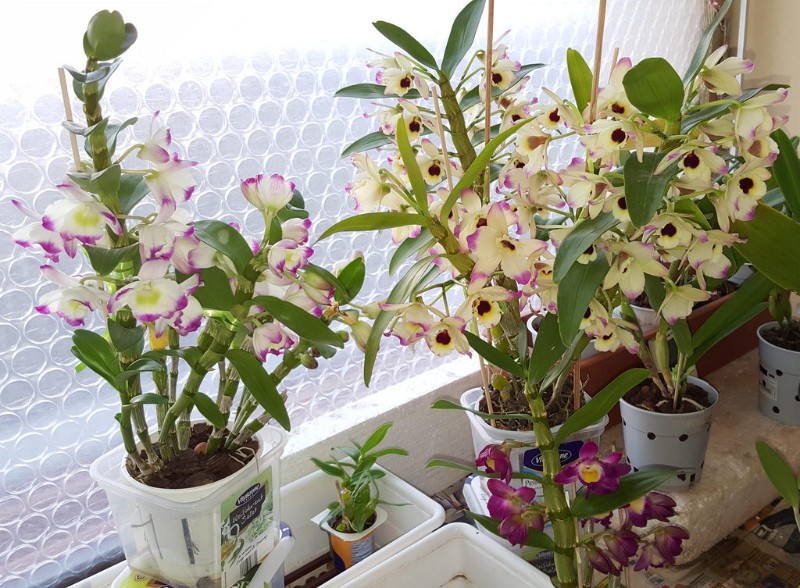
Common Problems With Dendrobium Nobile Orchids
No guide to how to care for a dendrobium nobile orchid would complete without some detail about the common problems and how to fix them. Thankfully, dendrobiums are fairly easy to care for and most problems can be fixed if you are paying close attention to the health of your orchid.
Yellow Leaves
Dendrobium nobile orchids can develop yellow leaves after the flowering phase, as they are deciduous and you can expect at least some of the leaves to yellow, wither and fall from the plant. If this happens, don’t worry, it is a normal part of the plant’s life cycle.
Old leaves will be the ones most likely to be shed from the plant, so keep an eye on this. If you see yellowing of the new growth during the growing season, suspect a problem with the plant.
Yellow leaves can be due to either overwatering or underwatering. Feel the leaves to check them for dryness. Dry and crunchy leaves are either a sign of underwatering or sun damage.
If the leaves are not crunchy, check the potting medium. If it is waterlogged, you should examine for any signs of root rot. If you detect this, you should immediately repot the orchid, removing any affected roots, and reduce watering going forward.
Yellow leaves can also be due to underfeeding, particularly during the vegetative growth phase, where nitrogen deficiency can cause leaf chlorosis. However, if you are feeding your orchid with an orchid fertilizer at least once per month, the chance of nutrient deficiency is virtually nil.
Excessively high or low temperatures can cause yellowing of the leaves due to the stress that this will put the plant under. Consider getting a digital thermometer which records the current, maximum and minimum temperatures in the growing area.
Orchid disease and infestation can also cause leaf yellowing, so examine the soil, and both the top and bottom of the leaves for any sign of disease or infestation. If you identify disease, make sure to treat it immediately and take steps to prevent recurrence.
Drying Out
As mentioned previously, insufficient watering can cause dry, brown and crunchy leaves, but it will also cause leaf wilting and drying and
You should generally water them once the surface of the soil is dry during the growing season, from approximately March to September, and only let them dry out in their period of dormancy from October to December.
You should easily be able to identify an underwatered dendrobium nobile orchid due to dry, wilting leaves, shrivelled canes and dry potting media. Increase watering and the plant should recover, taking care to monitor the dryness of the potting media going forward.
Wilting
Many of the same reasons that can cause yellowing of the leaves can also cause wilting. Over and underwatering are probably the most common reasons for wilting, so assess the potting media and roots to see which is more likely. Otherwise, consider the same factors that we discussed earlier.
Dendrobium Nobile Orchid Pests
Dendrobium nobile orchids are fairly resistant to pests, but there are a few to watch out for. Scale is the most common pest found on dendrobium nobile orchids, but they can also be affected by mites, mealybugs, thrips, whitefly, fungus gnats. For more information on how to identify and treat pests on dendrobium nobile orchids, see the AOS website, which has a wonderful resource.
Diseases
Fungal and bacterial diseases are more likely in an overwatered plant or where there is excessive humidity. Bacterial soft and brown rot is a bacterial disease that causes sunken water-logged patches on the leaves.
Fungal Pythium and Phytophthora can cause black rot which can quickly devastate a plant. High humidity and temperatures increase the risk.
Botrytis is another fungal disease that can cause unsightly black spots on the blooms, destroying the beauty of the flowers. Again, high humidity, standing water and cool conditions increase the risk. For more information about identification and treatment of common dendrobium diseases, see the AOS website.
Pyllosticta is another fungal disease which causes widespread small black spots on the leaves. This can spread very rapidly among plants
I hope you have found this guide helpful. If you have any questions about how to care for a dendrobium

